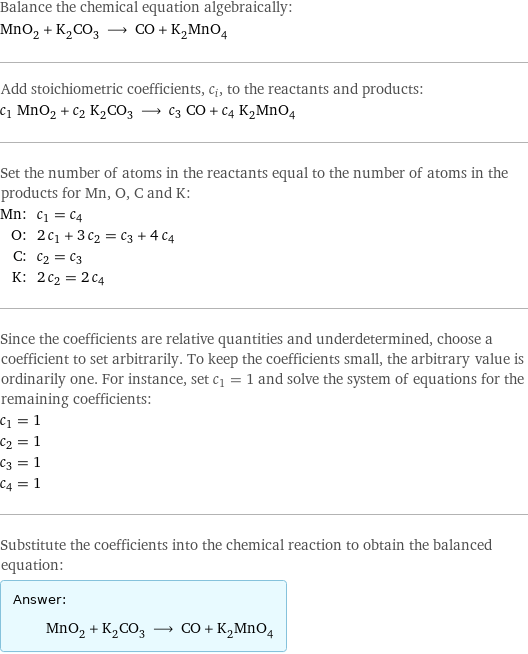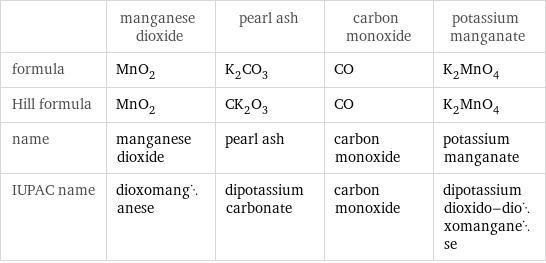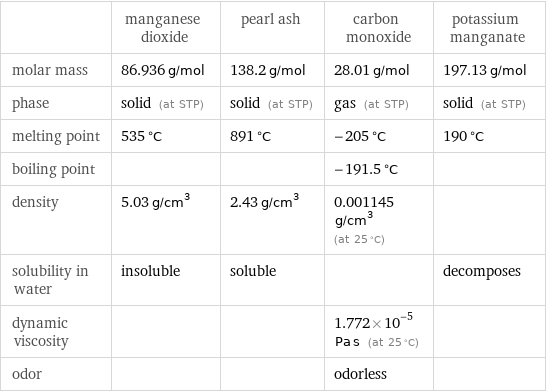Input interpretation

MnO_2 manganese dioxide + K_2CO_3 pearl ash ⟶ CO carbon monoxide + K_2MnO_4 potassium manganate
Balanced equation

Balance the chemical equation algebraically: MnO_2 + K_2CO_3 ⟶ CO + K_2MnO_4 Add stoichiometric coefficients, c_i, to the reactants and products: c_1 MnO_2 + c_2 K_2CO_3 ⟶ c_3 CO + c_4 K_2MnO_4 Set the number of atoms in the reactants equal to the number of atoms in the products for Mn, O, C and K: Mn: | c_1 = c_4 O: | 2 c_1 + 3 c_2 = c_3 + 4 c_4 C: | c_2 = c_3 K: | 2 c_2 = 2 c_4 Since the coefficients are relative quantities and underdetermined, choose a coefficient to set arbitrarily. To keep the coefficients small, the arbitrary value is ordinarily one. For instance, set c_1 = 1 and solve the system of equations for the remaining coefficients: c_1 = 1 c_2 = 1 c_3 = 1 c_4 = 1 Substitute the coefficients into the chemical reaction to obtain the balanced equation: Answer: | | MnO_2 + K_2CO_3 ⟶ CO + K_2MnO_4
Structures

+ ⟶ +
Names

manganese dioxide + pearl ash ⟶ carbon monoxide + potassium manganate
Equilibrium constant
![Construct the equilibrium constant, K, expression for: MnO_2 + K_2CO_3 ⟶ CO + K_2MnO_4 Plan: • Balance the chemical equation. • Determine the stoichiometric numbers. • Assemble the activity expression for each chemical species. • Use the activity expressions to build the equilibrium constant expression. Write the balanced chemical equation: MnO_2 + K_2CO_3 ⟶ CO + K_2MnO_4 Assign stoichiometric numbers, ν_i, using the stoichiometric coefficients, c_i, from the balanced chemical equation in the following manner: ν_i = -c_i for reactants and ν_i = c_i for products: chemical species | c_i | ν_i MnO_2 | 1 | -1 K_2CO_3 | 1 | -1 CO | 1 | 1 K_2MnO_4 | 1 | 1 Assemble the activity expressions accounting for the state of matter and ν_i: chemical species | c_i | ν_i | activity expression MnO_2 | 1 | -1 | ([MnO2])^(-1) K_2CO_3 | 1 | -1 | ([K2CO3])^(-1) CO | 1 | 1 | [CO] K_2MnO_4 | 1 | 1 | [K2MnO4] The equilibrium constant symbol in the concentration basis is: K_c Mulitply the activity expressions to arrive at the K_c expression: Answer: | | K_c = ([MnO2])^(-1) ([K2CO3])^(-1) [CO] [K2MnO4] = ([CO] [K2MnO4])/([MnO2] [K2CO3])](../image_source/781eed689e5a53608e01036ca1ae93d1.png)
Construct the equilibrium constant, K, expression for: MnO_2 + K_2CO_3 ⟶ CO + K_2MnO_4 Plan: • Balance the chemical equation. • Determine the stoichiometric numbers. • Assemble the activity expression for each chemical species. • Use the activity expressions to build the equilibrium constant expression. Write the balanced chemical equation: MnO_2 + K_2CO_3 ⟶ CO + K_2MnO_4 Assign stoichiometric numbers, ν_i, using the stoichiometric coefficients, c_i, from the balanced chemical equation in the following manner: ν_i = -c_i for reactants and ν_i = c_i for products: chemical species | c_i | ν_i MnO_2 | 1 | -1 K_2CO_3 | 1 | -1 CO | 1 | 1 K_2MnO_4 | 1 | 1 Assemble the activity expressions accounting for the state of matter and ν_i: chemical species | c_i | ν_i | activity expression MnO_2 | 1 | -1 | ([MnO2])^(-1) K_2CO_3 | 1 | -1 | ([K2CO3])^(-1) CO | 1 | 1 | [CO] K_2MnO_4 | 1 | 1 | [K2MnO4] The equilibrium constant symbol in the concentration basis is: K_c Mulitply the activity expressions to arrive at the K_c expression: Answer: | | K_c = ([MnO2])^(-1) ([K2CO3])^(-1) [CO] [K2MnO4] = ([CO] [K2MnO4])/([MnO2] [K2CO3])
Rate of reaction
![Construct the rate of reaction expression for: MnO_2 + K_2CO_3 ⟶ CO + K_2MnO_4 Plan: • Balance the chemical equation. • Determine the stoichiometric numbers. • Assemble the rate term for each chemical species. • Write the rate of reaction expression. Write the balanced chemical equation: MnO_2 + K_2CO_3 ⟶ CO + K_2MnO_4 Assign stoichiometric numbers, ν_i, using the stoichiometric coefficients, c_i, from the balanced chemical equation in the following manner: ν_i = -c_i for reactants and ν_i = c_i for products: chemical species | c_i | ν_i MnO_2 | 1 | -1 K_2CO_3 | 1 | -1 CO | 1 | 1 K_2MnO_4 | 1 | 1 The rate term for each chemical species, B_i, is 1/ν_i(Δ[B_i])/(Δt) where [B_i] is the amount concentration and t is time: chemical species | c_i | ν_i | rate term MnO_2 | 1 | -1 | -(Δ[MnO2])/(Δt) K_2CO_3 | 1 | -1 | -(Δ[K2CO3])/(Δt) CO | 1 | 1 | (Δ[CO])/(Δt) K_2MnO_4 | 1 | 1 | (Δ[K2MnO4])/(Δt) (for infinitesimal rate of change, replace Δ with d) Set the rate terms equal to each other to arrive at the rate expression: Answer: | | rate = -(Δ[MnO2])/(Δt) = -(Δ[K2CO3])/(Δt) = (Δ[CO])/(Δt) = (Δ[K2MnO4])/(Δt) (assuming constant volume and no accumulation of intermediates or side products)](../image_source/f9cdd2abfc9f0a7c3cf6bcaf67120d0d.png)
Construct the rate of reaction expression for: MnO_2 + K_2CO_3 ⟶ CO + K_2MnO_4 Plan: • Balance the chemical equation. • Determine the stoichiometric numbers. • Assemble the rate term for each chemical species. • Write the rate of reaction expression. Write the balanced chemical equation: MnO_2 + K_2CO_3 ⟶ CO + K_2MnO_4 Assign stoichiometric numbers, ν_i, using the stoichiometric coefficients, c_i, from the balanced chemical equation in the following manner: ν_i = -c_i for reactants and ν_i = c_i for products: chemical species | c_i | ν_i MnO_2 | 1 | -1 K_2CO_3 | 1 | -1 CO | 1 | 1 K_2MnO_4 | 1 | 1 The rate term for each chemical species, B_i, is 1/ν_i(Δ[B_i])/(Δt) where [B_i] is the amount concentration and t is time: chemical species | c_i | ν_i | rate term MnO_2 | 1 | -1 | -(Δ[MnO2])/(Δt) K_2CO_3 | 1 | -1 | -(Δ[K2CO3])/(Δt) CO | 1 | 1 | (Δ[CO])/(Δt) K_2MnO_4 | 1 | 1 | (Δ[K2MnO4])/(Δt) (for infinitesimal rate of change, replace Δ with d) Set the rate terms equal to each other to arrive at the rate expression: Answer: | | rate = -(Δ[MnO2])/(Δt) = -(Δ[K2CO3])/(Δt) = (Δ[CO])/(Δt) = (Δ[K2MnO4])/(Δt) (assuming constant volume and no accumulation of intermediates or side products)
Chemical names and formulas

| manganese dioxide | pearl ash | carbon monoxide | potassium manganate formula | MnO_2 | K_2CO_3 | CO | K_2MnO_4 Hill formula | MnO_2 | CK_2O_3 | CO | K_2MnO_4 name | manganese dioxide | pearl ash | carbon monoxide | potassium manganate IUPAC name | dioxomanganese | dipotassium carbonate | carbon monoxide | dipotassium dioxido-dioxomanganese
Substance properties

| manganese dioxide | pearl ash | carbon monoxide | potassium manganate molar mass | 86.936 g/mol | 138.2 g/mol | 28.01 g/mol | 197.13 g/mol phase | solid (at STP) | solid (at STP) | gas (at STP) | solid (at STP) melting point | 535 °C | 891 °C | -205 °C | 190 °C boiling point | | | -191.5 °C | density | 5.03 g/cm^3 | 2.43 g/cm^3 | 0.001145 g/cm^3 (at 25 °C) | solubility in water | insoluble | soluble | | decomposes dynamic viscosity | | | 1.772×10^-5 Pa s (at 25 °C) | odor | | | odorless |
Units
